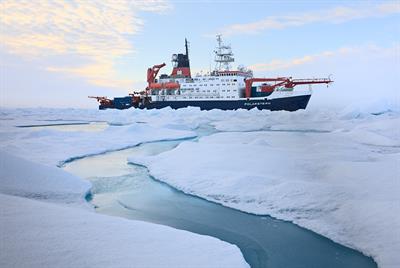
The MOSAiC expedition - A year trapped in the Arctic ice
Collection Editors
Helene Angot, Zoe Koenig, Michael Gallagher, Kevin PosmanViews
70 viewsParticipating Sections
Submission Deadline
Closed
About this collection
Following in the footsteps of Fridtjof Nansen’s ground-breaking expedition with his wooden sailing ship Fram in 1893-1896, the MOSAiC (Multidisciplinary drifting Observatory for the Study of Arctic Climate) expedition brought a modern research vessel full of scientists close to the North Pole (the northernmost point of the earth!) for an entire year. Different from other oceans, the Arctic Ocean is often covered with sea ice. This means that in winter the ice is very thick, making it difficult and dangerous to navigate, particularly in Nansen’s time. Early Arctic explorers were turned back or had their ships destroyed by the frozen ocean. However, Nansen’s daring voyage showed that it is possible to travel in a ship by “drifting” across the ice-covered Arctic Ocean. Nansen showed that a ship in the sea ice will be carried along with the ice by winds and ocean currents, showing it is possible to travel across the Arctic Ocean without sailing. The Fram’s drift was repeated from September 2019 to October 2020 with scientists on the German research icebreaker Polarstern (“Polar Star”), a ship designed to move through ice-covered waters, equipped with highly advanced scientific instruments to explore and record climate processes in the Central Arctic.In this collection, we want to tell you why hundreds of scientists from all around the world intentionally froze a ship in the Arctic sea ice for an entire year, braving subzero temperatures and months of polar darkness. We will talk about the different instruments used to explore the Arctic, from the high atmosphere to the deep Arctic Ocean, through the snow and the sea ice. We will investigate how the Arctic climate system works, from the molecular to hundred of kilometer scale. We will explain how the Arctic changes and how the air, the sea ice, and the ocean interact. We will explore the life of a floe (a piece of sea ice), from its creation to its disappearance, and the life that is hosted in and below it. We will give you a hint on how the Arctic system looked like in 2020 and how it compares with the Arctic as observed during the Fram expedition. We will also see how the observations collected during this entire year are used to improve models to better understand the climate and what will happen in the future. Finally, we also want to explain how we did that, from food deliveries to daily life on the ice surrounded by polar bears.
Embark with us on the largest polar expedition in recent history!
Would you like to submit to this collection?
For researchers interested in submitting to this Collection, please consult our author guidelines and check that you have all the essentials included before submitting



